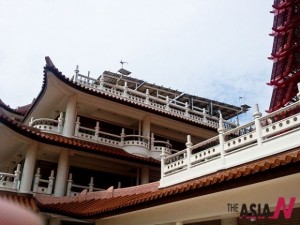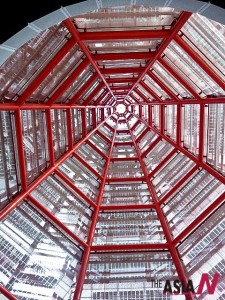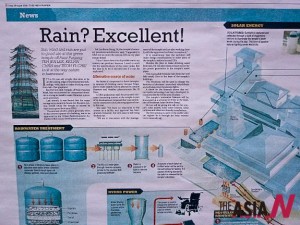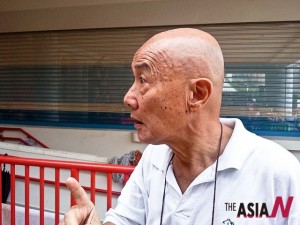A Singaporean temple goes ahead in practicing green energy
Singapore, President of Asia Journalist Association
Spiritual food for the soul is what you get when you visit any Buddhist shrine in Asia … until you step into the Poh Ern Shih (Temple of Thanksgiving) in Singapore. There, you will receive something more, something scientific and enlightening too.
At this Chinese-style Mahayan shrine, devotees come and pray to the Buddhist saint, the ‘Great Vow’ Ksitigarbha Bodhisattva who pledges to save lost souls in Hell.
But also to seek healing and blessings from the ‘Medicine’ Buddha, Amitabha Buddha and Kuan-yin Goddess of Mercy.
And even more, they lend a hand in saving Mother Earth. Through their donations, the temple is able to invest in solar panels and wind turbines to producing energy.
 Since 2009, Poh Ern has generated its own electricity for lighting and heating, earning it the accolade of Singapore’s first green temple.
Since 2009, Poh Ern has generated its own electricity for lighting and heating, earning it the accolade of Singapore’s first green temple.
The well-publicised temple’s do-it-yourself style is novel as practically everybody else is content with buying their power and water from a public utilities corporation.
Poh Ern Shih used to chalk up $200 to $300 a month in utilities bill. Its president, Mr Lee Boon Siong, 72, a retired lawyer back from Canada and grandson of the temple founder, aims to make it self-sufficient in power and waters He thinks Singaporeans may be behind time in using renewal resoucres from sun and rain..
He said: “I was there, in Vancouver (40 years ago), and was surprised to see the use of solar panels on buildings, schools and apartments. In the oceans there were wind turbines the size of ships.
“In houses in the forests we had no piped water and had to draw water from lakes or collect rainfall or melting snow from roofs using stainless steel barrels.”
Taking over the management, Lee brought a fresh vision to the task of renovating the temple complex to better serve the needs of an aging cohort of worshippers. Not only will it be wheelchair-friendly for the elderly, the new six-story temple will meet the young people’s conservation interest and concerns.
In 2003, he set out to replicate his Canada experience in his own turf.
Getting down to the drawing board with his architects, he saw that its hilltop perch allows the 58-year-old temple to employ affordable green technology for harvesting rain water and harnessing energy from the wind and sun..
Never mind the blending, up went an array of rectangular solar panels on the tiled roof to convert the sun’s ray into electricity for lighting. At the edge of the higher floor balcony are drum-like heaters that boil the water. Rising above these is a showpiece glass pagoda fitted out with photovoltaic cells that symbolizes the temple’s drive for green energy.
Even breezes flowing from the sea are harnessed by small wind turbines on the south-facing temple to churn out power to charge electric wheelchairs for elderly worshippers.
“Right now we are connected to the national power grid,” Lee said of the fruits of a five-year effort.
“The wattage the temple produces goes into the grid and we get reverse credit for what we use,” said Lee.
The temple would be able to produce more electricity than it needs when more solar panels are put up soon. Plus a little more from running rainwater from the top floors through the hydro-electricity devices inside the hollows of temple beams.
“I would then be able to sell power to the government.”
Lee is confident he would be able to get a return on his $200,000 solar panel outlay within five years, now that the price of electricity has risen to 40 cents from 8 cents per watt five years ago.
Poh Ern Shih is also equipped to catch rainfall for its water needs..
“In Singapore we have good rainfall. Under English law of real estate, anything that falls from the sky into your land is yours,” said Lee.
The temple has in place a system of pipes and subterranean storage tanks to collect rain water and purifying it by micro-fibre filtration and UV light treatment. Some of the potable water is bottled and blessed as holy water for devotees.
Lee makes every drop count by using the raw water to irrigate plants and to wash and clean the temple grounds.
Where it could, the hill-top temple cuts down on energy by doing without air-conditioning. For instance, the meditation hall cools itself by allowing the warm air to rise and escape through a vent in the high ceiling.
“This is the kind of natural air circulation you feel inside a mosque with its tall spire,” said Lee.
Poh Ern Shih’s conservation mission reflects the Buddhist compassion for all life. Butterflies are attracted to the temple’s sloping gardens, thanks to flowering shrubs that offer them nectar and leaves for laying their eggs.
to flowering shrubs that offer them nectar and leaves for laying their eggs.
”As Buddhists, we have to be kind to all creatures, big and small, ” said Lee, who had been educated in a Christian mission school and embraced the faith only after taking over the temple’s management. “Remember that Lord Buddha always lived close to Nature and give lectures in the open.”
The temple is a haven for cats brought in by worshippers. Lee and his wife Connie have so far adopted half a dozen cats.
Buddha’s concept of the environmental conservation is best summed up in this saying of his: “As a bee, without harming the flowers, its colour or scent, flies away, collecting only the honey, ever so should the sage wander in the village.”
Truly, conservation brings with it the blessings of economy. By tapping the heavens for energy and water, at what is seen as a relatively high price, Poh Ern Shih is beginning to reap gains from its green spending.
It is also blessed with a good location and a motivated chief executive who has a full mandate to pursue his green dream. Since the good spread of positive write-ups on Singapore’s first green temple, many people have visited and spoken to Lee about his eco-enterprise.
The promising thing is that he is ever-ready to share his experience and know-how with those who are keen to have a go at green power.
“Whether it is in Singapore or the rest of Asia, we have all — Buddhists or others — to do something quickly to reverse the effects of pollution caused by the use of coal and oil for produce energy,” he said.
Perhaps Singaporeans and others would have Poh Ern Shih to thank for practising and not just preaching what Buddha and the world’s religious leaders have taught on ecological ethics and human well-being.
*Notes: Poh Ern Shih is so-called Temple of Thanksgiving owing to two dramatic incidents during the Japanese Occupation years when Singapore was known as Syonan. One involved the temple founder Lee Choon Seng who felt grateful for having survived an assassination attempt in 1942. Another was his gratitude and indebtedness to 850 Malay youths who was recruited by the British colonial authorities into a regiment charged with resisting the Japanese invasion of Singapore from the sea. They were killed in the fighting on a hill overlooking the site of the temple.
